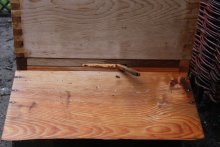The first Wasp
I saw the first worker wasp of the season. She was hovering near Colony 1.
Earlier this season we saw a lot of Queen wasps. This suggests that it may be a waspy year. There have also been lots of aphids for the wasps to feed on. Wasps require mostly protein early in the seasons which they use to feed their brood. They switch increasingly to needing sugar during the season, which is why they try to rob honey bee colonies.
- Read more about The first Wasp
- Log in or register to post comments
